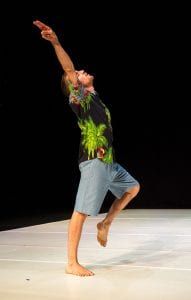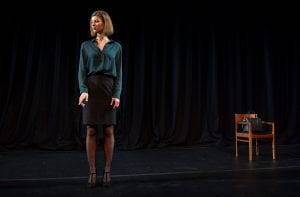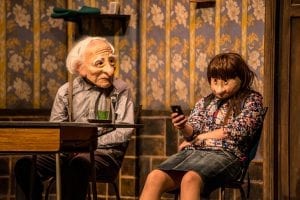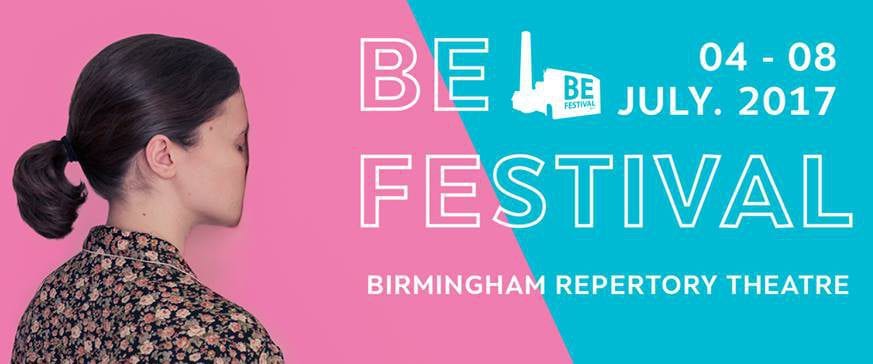From acrobatic feats to storytelling, from circus to puppetry and from mime to contemporary dance – a huge variety of theatrical forms shapes the BE Festival’s repertoire this year. Via the slogan “The soul of Europe in the heart of Birmingham” the City’s annual Summer Festival not only provides a vivid platform for emerging artists, but builds a unique experience of a European community in the Midlands. But what does it mean to be part of this community? What are the functions of borders? How can we maintain a dialogue between Europe and the UK one year after the Brexit-Referendum?
These and other questions provide a thematic line through this year’s festival program and particularly dominate its Visual Arts program: While Kristina Cranfeld and John Harrigan’s site specific performance “British Enough?” investigates identity politics in the UK, the Frankfurt based performance collective MAMAZA draws a red line between Birmingham’s Ladywood area and The Rep – this year’s Festival venue – in “Asingeline, an enacted thought”, negotiating the function of physical and imaginative boarders. Beside these installations the program offers various workshops, feedback cafés and obviously a versatile performance program.
The artistic directors of the festival Isla Aguilar and Miguel Oyarzun invited over 15 performances from Greece, Spain, Portugal, Italy, the Netherlands, Hungary, France, the United Kingdom, Germany and Switzerland for the main program. Every performance was commissioned for a 30 minute version, which enabled the program to present four

performances every evening covering various theatrical genres. While Marco D’Agostin’s one-man show “Everything is ok” investigates cultural overload through a mixture of spoken word and an extensive gestural collage, Elsa Couvreur from Woman’s Move interacts with a robotic voice on stage and therefore ironically negotiates the feeling of being “on hold” in European bureaucracy in “The Sensemaker”. The sad masks by Kulunka Teatro not only tell a story without words about aging and being disconnected in “Solitudes”, but also create a well-known type of situation for most of the audience members with infirm elderly relatives. Probably due to its sensitive and touching approach to such an individual but at the same time universal topic this performance was honoured with this year’s audience award.

The BE Festival was established in 2010 aiming to provide a platform for new theatrical tendencies in the UK and therefore, facilitating cultural exchanges between European and UK-based artists. First located in a factory in Birmingham’s jewellery quarter, the festival moved to well-known Birmingham Repertory theatre, turning it upside down. The festival HUB, a welcoming retro-nostalgic world in the theatre’s backstage area, provided a meeting point for audience members, with the festival team and artist sharing their experiences, spending their Karma (a fake festival currency) on drinks and listening to the late-night music program. Enforcing the dialogue about theatre and community-building seems to be the most outstanding characteristic of the festival, which is supported by the interval-dinner party on The Rep’s main stage every evening. This particular atmosphere of gathering together and being part of a larger discussion about new theatrical tendencies in the European, mostly fringe, performance scene marks this festival as a crucial landmark in

continental and UK’s festival circuit.
Not only does the festival focus on emerging artists and presents them to a wide range of invited programmers and venues, the high profiled jury members (e.g. Selma Spahic, the artistic director of Sarajevo’s international festival MESS, or James Pidgeon, the programmer of Shoreditch Town Hall in London) award the winning performances with five different prizes, either inviting a performances to an international European Festivals (e.g. Bilbao’s ACT Festival), or offering a fully supported two-week creative residency in Birmingham. The BE festival not only provides an important insight into contemporary theatre practice, but also builds a network for young, emerging artists within the European festival circuit. Due to the visibility it provides for artists, the possibilities for international cooperation and touring as well as the festival’s high-profile network with other festivals and venues turns it into a repertoire-building institution, which arouses curiosity for next year’s program.

